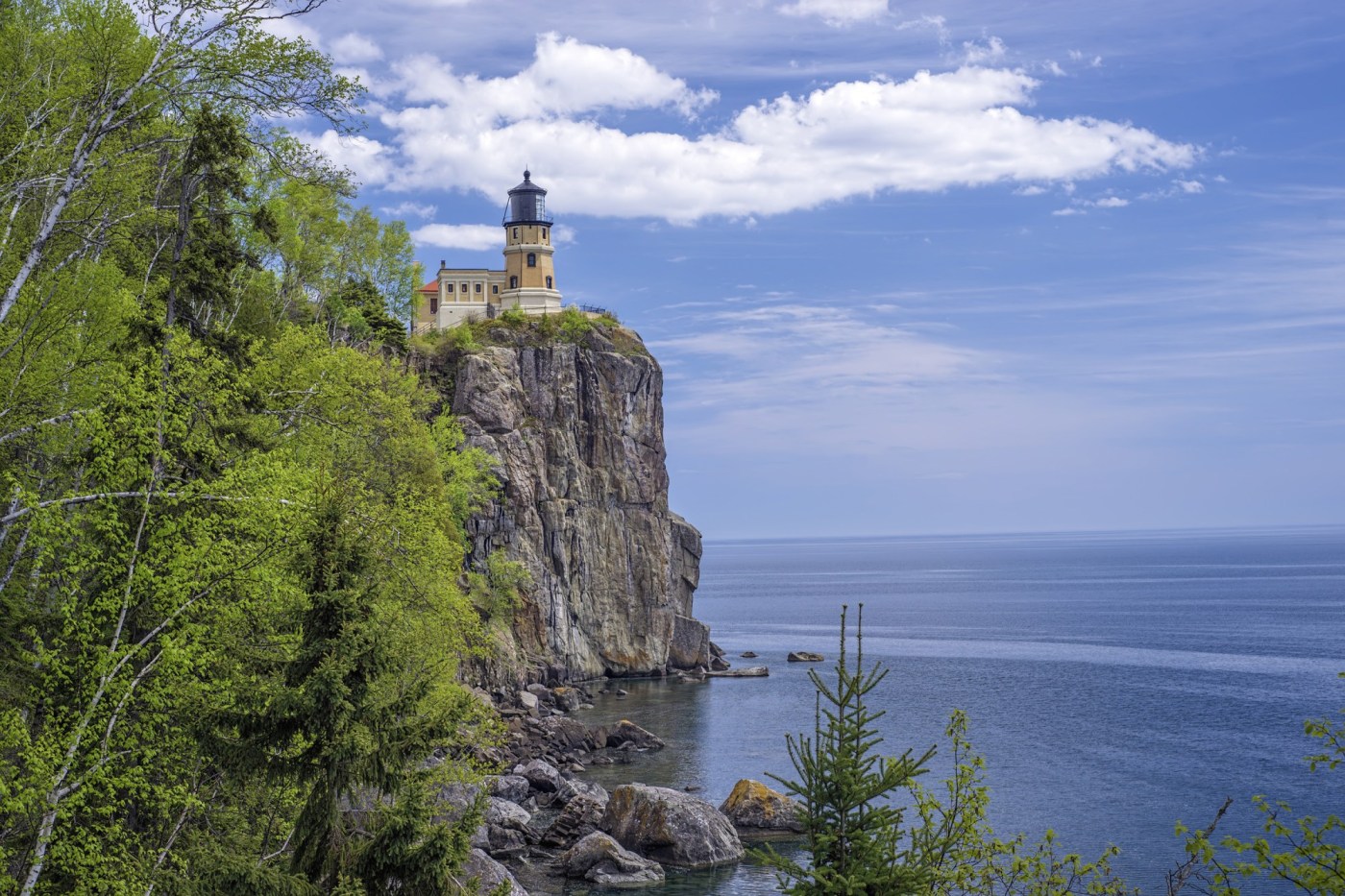
More states strive to make parks, trails accessible to people with disabilities
TWO HARBORS, Minn. — Perched high on rugged cliffs overlooking Lake Superior, Split Rock Lighthouse dominates the shoreline. Visitors from across the country make the 113-year-old beacon one of the most-photographed lighthouses in the country.
The most spectacular view, many say, is from Pebble Beach, reachable only by a steep, winding forest trail that snakes its way to the rocky shore. The view is the reward for the effort it takes to reach the beach, but for visitors with mobility challenges, it could be inaccessible.
“I’ve lived here for 43 of my years and I did not know where all these photographers were getting those things,” said Jenna Udenberg, a disability advocate and accessibility educator who lives in Two Harbors.
No longer. Since August, the park has provided an all-terrain chair with tanklike treads to people with disabilities, opening this vista to everyone. It’s part of a multifaceted statewide push to expand access to the outdoors.
Minnesota is not alone.
In recent years, there has been a growing awareness of the need to make outdoor recreation more accessible, said Mike Passo, executive director of American Trails, which supports the development of trails and greenways. Passo said other states including California, Michigan, Vermont and Wisconsin also have made significant strides.
In Minnesota, such efforts got a significant boost earlier this year when legislators funded the Department of Natural Resources’ $149.9 million Get Out MORE (Modernize Outdoor Recreation Experiences) initiative.
Major pieces include $34.5 million for more accessible recreational equipment and revitalized trails in parks and on public lands and $9.5 million to modernize facilities such as campgrounds and lodges, many of which date to the Depression-era Civilian Conservation Corps and Works Progress Administration.
Chair opens new territory
Udenberg was diagnosed with juvenile arthritis at age 7 and began using a wheelchair at 8. Her access to the best beaches vanished. Although she supplemented her manual chair with a power unit, trails like those at Split Rock Lighthouse State Park were too steep.
“It [her powered chair] would get down, but there’d be no way of getting back,” she said.
Minnesota, which has the nation’s second-oldest state park system, purchased track chairs for five state parks in 2022 and expanded the program to 13 parks, including Split Rock, this year. They span from the rugged northeastern shoreline, home to moose and wolves, to Blue Mounds on the state’s southwestern prairie, where the trails offer the chance to spot grazing bison.
At Split Rock, which attracts more than half a million visitors annually, officials tested the chair on the park’s terrain, documenting routes that would fit the chair’s range. Steep climbs drain the battery more than flat terrain, so park employees have mapped out suggested routes to tackle in the 2,200-acre park. There is no charge to use the chair.
In the first 35 days of the program, the chair was reserved 22 days, said Ward Wallin, park supervisor at Split Rock.
“People are using it, they’re posting on Facebook and other social media outlets, and I think pretty soon it’s going to be really, really packed,” said Wallin, who added that park officials plan to test the chair for winter use.
The chairs range in cost from $14,000 to about $20,000, according to Adam Henning, marketing manager at Action Manufacturing, which manufactures the chairs used in Minnesota parks. Michigan (13 locations) and Georgia (10 locations) also were early adopters and have chairs in multiple locations, he said.
“A lot of state parks have taken notice,” he said.
Push for accessibility
Michigan has taken a different approach, primarily relying on private money to pay for track chairs in its state parks. The Department of Natural Resources website lists more than a dozen parks and recreation areas with a total of 18 chairs in place or coming soon. It also includes something the Minnesota site does not: a donation button.
Wisconsin’s Open the Outdoors program offers wide-ranging opportunities, from beach-capable chairs to cross-country sit skis, but the state is taking a measured approach to track chairs. User needs vary, said Nick Zouski, accessibility coordinator for the Wisconsin Department of Natural Resources, and a chair designed for an urban park might not work for a hunting area. Also, money is limited.
Iowa also has budget concerns and is exploring outside funding options for chairs, according to Sherry Arntzen, bureau chief for parks, forests and preserves with the Iowa Department of Natural Resources. In the meantime, the agency has made gains in providing modified kayak launching areas. A current priority is auditing and updating facilities, including historic structures nearly 100 years old, to improve their accessibility.
“If there’s things that we’re not providing that we should be, we’re identifying now so then we can put that plan together to make those additional modifications as needed, because just like other park systems, you’ve got a gamut on the age of some of your infrastructure,” Arntzen said.
Some state parks also offer chairs that bring visitors onto beaches or even into the water. In several Massachusetts state parks, for example, visitors can use four-wheeled sunbathing chairs on the beach, or three-wheeled floating chairs in the ocean.
The track chair project drew Minnesota’s major news outlets to state parks, putting a media spotlight on the state’s accessibility program. While advocates commended the commitment, the praise came with a caution.
“There still is a lot of work to be done,” said Erika Rivers, executive director of Wilderness Inquiry, a Minnesota-based nonprofit that promotes access to the outdoors for all. Rivers emphasized that investing in accessibility ultimately benefits everyone.
“We are all temporarily able-bodied,” she said.
As much as technological gains and new programs help, experts and advocates said improving access does not always require major expenditures. In reaching a community that long had no or limited access to outdoors recreation, communication is vital.
“If you … change nothing and get that information available to people, in my opinion, that increases accessibility by like 80%,” said Passo. “Every person with a disability has different needs and if I understand what I’d be getting into, then I can choose the experience that’s going to be accessible to me.”
Track chairs serve a certain segment of users, Rivers said, but she noted that her group favors “less invasive” means of access, a core value that goes back to the group’s founding in the 1970s. Whether paddling down an urban river or exploring deep into Minnesota’s remote, motor-restricted Boundary Waters Canoe Area Wilderness, the organization subscribes to a low-impact, leave-no-trace ethic. “You don’t need to add that kind of technology,” she said.
Passo also cautioned that states should place reasonable restrictions on technologies such as track chairs. Some states are expanding motorized hunting for people with disabilities, he said, but “the disability community doesn’t want to be kind of used as a tool for increasing motorized access in areas that really shouldn’t have it.”
Whether states plan a high-profile initiative such as track chairs or something as basic as making a campsite grill accessible, planners must consider current guidelines under the federal Americans with Disabilities Act as the baseline, advocates say.
Signed into law in 1990 to prevent discrimination against people with disabilities and guarantee access in public spaces, the ADA was strengthened with tougher building and other standards in 2010.
But the push to expand recreational accessibility “is not about being compliant, it’s about being committed,” Udenberg said. “I think having that mindset changed — that it’s not just because the law says we should, it’s because we want to.”
Stateline is part of States Newsroom, a national nonprofit news organization focused on state policy.
©2023 States Newsroom. Visit at stateline.org. Distributed by Tribune Content Agency, LLC.

